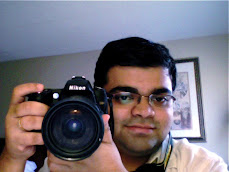If I had taken this photo in JPEG format, I would have had a tough time to recover the details without botching up. Mind you - asking my friend to pose for the shot again was not possible! The point is that the image sensor of my camera (Nikon D90) is actually sensitive enough to capture a lot more detail and it did. But it is not apparent on the JPEG because the JPEG processor used only part of the dynamic range of the data to render the image, thus sacrificing on the detail.
I toook the RAW image into Capture NX2, I pumped up the exposure compensation to +2 (This brings out the detail in the dark - just like 'pushing' ISO 100 film to behave like an ISO 400 film). I set shadow protection to 10 (brought out more detail and more noise with it) and then a noise-reduction to minimise the effect of noise. I then converted it to a Black-and-white image (for the feel) and this is what I got.
If I hadn't used the RAW option, this image would have been unusable.
I totally understand that shooting in RAW takes a lot of precious memory space, and the amount of work involved is a lot. I bought enough memory (memory is cheap) and I use the processing power of my laptop at night (many a times, my laptop runs overnight to convert my NEFs to JPEGs using my specific settings. 95% of the photos look good with batch-processing and then I dump the associated NEFs. The rest of the 5% can be vastly improved by manually developing the NEFs. Then there's the 1% of shots (like the one above) that have some creative potential in them and I love to spend a lot of time developing and re-developing them till I get the picture the way I want it.
Using RAW, you're using your expensive image sensor to the best capability. Shooting in RAW is not as painful as people portray it to be. You don't even need specialized software because the latest version of Picasa seems to handle RAW files from most of the popular cameras, so maybe you should give it a try. Believe me, it's worth it.



